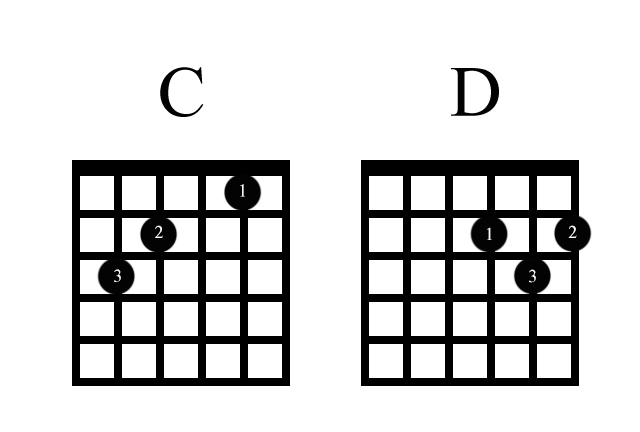Practicing Guitar is Problem Solving

If your practice time doesn’t include some thoughtful problem-solving, you probably aren’t getting as much out of it as you could.
It doesn’t matter if you started playing 40 years ago or yesterday. If you miss a note consistently, it’s a mechanical problem. Every mechanical problem has a mechanical solution.
Notes don’t sound for two basic reasons. The problem is either in the arrival or the departure: the way you land or the way you let go. So we start the process by deciding which it is. Ask yourself the following questions:
-
Which finger is landing on the new note?
-
Which finger held the previous note? Can you prepare or set up the landing?
-
What orientation of the hand brings the finger closest to the target note?
Let’s say you’re working with a transition from an open position C chord to an open position D. These should be familiar:
If you struggle with a chord change like this one, the problem usually has to do with finger placement. Most people are so busy trying to land each finger that they don’t notice their hand.
The standard fingering for a C chord has the ring finger on string 5 and the index on string 2. This usually places the palm more or less level with the bottom of the neck. When we move to the D chord, those two fingers flip their orientation. In the C form, the ring finger is above the index. The D chord fingering is the reverse: index above middle and ring.
Rotating the entire hand and arm carries the fingers into position. The arm movement does most of the work so that the fingers end up more or less hovering over their assigned notes. Now it’s much easier to land accurately, because you aren’t working nearly as hard to get there.
This approach condenses three movements into one. Instead of thinking of three fingers, think of the two shapes and the arm flip that connects them. If both chords don’t ring clearly, the issue is either in how you release the C or land on the D.
We don’t lift our fingers off the strings, we release them.
If we’re proceeding with the premise that the arm does most of the work, it would make sense to say the fingers just need to let go. But the fingers will often carry residual tension, especially if you tend to “grip” your chords. This tension makes it harder to control the fingers effectively and make a clean landing on the target note.
To practice a longer chord sequence or lick, repeat this process, first with the note that follows the problem spot and then the one that precedes it. Gradually add more notes on either side until you can play the entire passage smoothly.
It’s a slow process, so give it time. Most importantly, SLOW DOWN. You need to move slowly enough that you can really control your hands. Once muscle memory is engaged it’s basically impossible to get ahead of. So we need to bypass any established muscle memory and replace it with a more detailed and controlled model.
Playing out of time like this, the song won’t sound much like it’s supposed to.
But that’s not the point right now. Our goal at the moment is not to play the song but to create an exercise out of it. Once we’ve looked more closely at the movements, we can perform them more accurately in time.
This might be a new way of thinking for you. We’re very accustomed to hearing how repetition is important, and that IS true. But blind repetition won’t get you anywhere, so learn to slow down and pay closer attention!
Remember that effective practicing is a process. It’s possible to learn a song by just starting at the first note, playing to the last note, and doing it again. But before long, it becomes clear that some things are easier than others. So we need to concentrate more on those things, and also work to integrate them smoothly. It’s simple problem solving, and an important part of the process of learning to play.
Did you know JamPlay and TrueFire merged their video lesson libraries to form the industry’s most comprehensive guitar learning platform? Learn more by clicking HERE and check out the 70,000+ video guitar lessons on TrueFire.
Dave Isaacs has established himself as a guitar teacher extraordinaire, having built a strong set of educational curriculums for beginner, intermediate, and advanced guitar players alike. Dave shares his expertise largely through video platforms, but also through his thoughtful writing. You can take guitar lessons from Dave Isaacs via his comprehensive video guitar courses on TrueFire.com.
Share this
Become a JamPlay member for unlimited access to 7000+ guitar lessons and 120+ artists and instructors. View membership plans ›




